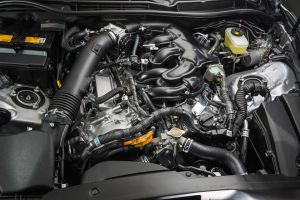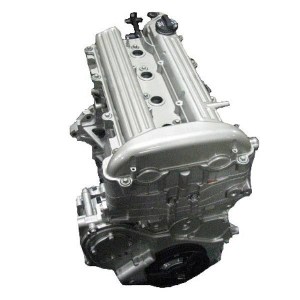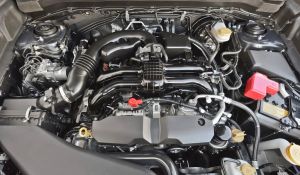
10 Cars With the Most Horrible Engines of All Time
We’ve taken a look at the worst of the worst engines ever made. But instead of focusing on just classic engines or modern mistakes, we’ve created a collage that focuses on both. Some were prone to catastrophic failure from day one, while others just plain under-delivered.
10. Cadillac V8-6-4
In 1981, the engineers at Cadillac took a swing at making an engine with cylinder-deactivating capabilities, much like what you see on many vehicles today. Dubbed the V8-6-4 (i.e. Displacement On Demand), this engine had the ability to deactivate or activate two cylinders at a time as power requirements demanded.
But the motor’s custom hydraulic lifters were controlled by failure-prone solenoids, and when they didn’t engage properly, lifters would collapse. This made throttle hesitation a major issue. And when cylinders deactivate, enormous amounts of lag were present, especially in such a heavy chassis. This problem was so widespread that dealers began to bypass the system. In today’s modern cars, cylinder deactivation works great, but 36 years ago, the technology just wasn’t there.
9. Mitsubishi 3-cylinder

An abysmal 78 horsepower is all you get out of the Mitsubishi Mirage’s three-cylinder. Car and Driver summed it up best in 2016, saying, “There is basically nothing to make a driver happy to be at the helm of a Mirage, nothing to love.”
The 1.2-liter sewing machine has extremely slow acceleration, and critics claim highway passing is both time-consuming and dangerous. Buyers can also expect a great deal of racket coming from the motor itself. One, critic at Kelley Blue Book referred to it as, “more noise, vibration, and harshness than you’ll get by putting bolts in a blender.”
8. Mopar 2.2-liter
Chrysler’s marketing campaign made it look like a winner. But the Mopar 2.2 quickly became known as a rod-knocker, and that was before Chrysler tossed a turbocharger into the mix. Everything from the Dodge Daytona to minivans received these powertrains in the 1980s. And almost all of them met the same fate in due time.
What’s interesting is that once upgraded with forged internals and aftermarket add-ons, the 2.2 turbo actually became a solid engine with surprising amounts of tuning potential. Unfortunately, it took the failures of thousands of earlier powerplants to bring on these revisions.
7. Oldsmobile V8 Diesel
Often referred to as “the diesel debacle,” General Motors’ decision to put crude combustion technology in an array of Oldsmobiles proved to be a costly mistake. Instead of utilizing a proven turbo-diesel powertrain or engineering a new one, the Detroit giant opted to “convert” gasoline engines to cut development costs. Buyers didn’t see just horrible performance numbers (120 horsepower and 220 pound-feet of torque), they also got one of the most problematic engines in history, which some still blame ruined interest in diesel cars.
While the diesel’s reinforced block was bulletproof, inferior head bolts began sheering off, and from there, things got worse. Hydrolock from leaking head gaskets, not having a water separator in the fuel system, and a sloppy timing chain could all cause catastrophic failures after just 30,000 miles. Eventually, a class-action lawsuit was filed because the problems were so widespread. In fact, the Olds diesel became so infamous, it inspired legislators across the country to draft the nation’s first lemon laws.
6. Lexus 2.5 V6

Lexus may have offered a plethora of modern technologies, but the lackluster motor from the previous generation IS 250 was anything but athletic. Power came from a pipsqueak of a 2.5-liter V6. It was both undersized and overly constricted by power-robbing emissions systems. It left both critics and drivers underwhelmed.
On a good day, the anemic V6 produced 204 horsepower and 185 pound-feet of torque, which is barely more than what you’ll find in the old Honda Civic Si, which had two fewer cylinders. In 2013, Consumer Reports referred to the old Lexus 250 as “neither sporty nor luxurious. Critics didn’t like the overall fuel economy ratings, at a 20/23/27 average.
5. Chevy 2.2-liter Ecotec

Don’t worry, the new 2.2-liter Ecotec is perfectly fine. It’s the pre-2006 generation you have to watch out for. The four-cylinder engine was infamous for refusing to provide power or reliability. Offered in everything from the Cavalier to the S-10 pickup, press reviews at the time urged buyers to stay away from these engines.
While a lack of power and durability were bad, corroding freeze plugs after 50,000 miles was one of the first-gen Ecotec’s major weaknesses. The editors at Hot Rod said, “It’s no wonder GM used absolutely no engineering or design from this engine when developing the (new) Ecotec.”
4. The First Ford V8
The iconic Ford flathead was the first production V8 engine from the Blue Oval and remained in production for over 20 years. It was an engine to move Americans into a new, faster era of transportation. But early versions of Ford’s mighty V8 were prone to all kinds of maladies. Piston rings were not properly hardened steel, which caused the engine to burn oil.
Due to cooling system design flaws, the rear cylinders always ran hotter than the front six. That, and the intake manifold never seemed to properly mix fuel with air. While one bank would run too rich, the other would run too lean. A quart of oil was typically burned every 100 miles, and both ignition and water pump woes were commonplace.
3. Jaguar V12
Hemmings finds that heat tends to be the cause of most V12 Jaguar engine issues. Since ignition and fuel were in close proximity to one another, both were prone to failure over time. While this design was chosen to alleviate space constraints, many still look at these engines as ticking time bombs.
Jaguar’s electrical system was also affected by the V12. The wiring closest to the engine would unravel and fry from the heat, causing electrical gremlins. And early versions of the engine also featured intakes that were covered in a snake farm of rubber hoses, which would crack and leak.
2. Subaru 2.0 and 2.5-liter (non-turbo)

Both 2.0- and 2.5-liter versions of the naturally aspirated boxer engine from Subaru have been objects of scrutiny in recent years due to excessive oil consumption. Initially waved off as something that “Subaru engines do,” owners were told they needed to add a quart of synthetic every few thousand miles. If the idea of a brand-new engine burning oil right off the lot concerns you, it should. It even led to the government stepping in.
The tipping point came in 2016 when Subaru finally admitted guilt and agreed to reimburse owners for repair costs. It also extended the length of its warranties. Subaru confessed that defective piston rings could cause some 2011–2015 vehicles to excessively burn oil. This led to a lawsuit that alleged that Subaru knew about the problem but neglected to tell owners. Dealers had to replace countless numbers of engine blocks.
1. Yugo 55
In late 1983, the Yugo 55 came with a 1.1-liter carbureted engine that generated an abysmal 55 horsepower and had one of the worst reliability ratings in history. With a top speed of just 86 miles per hour (if you were daring and going downhill), the Serbian subcompact was the slowest car n the United States at the time.
One critical maintenance issue that was unique was the need to replace the timing belt every 40,000 miles to reduce the risk of it snapping and destroying the engine. Needing premium gas was another strange requirement, and its finicky air pump-powered carburetor was both inefficient and detrimental to longevity. In the spring of 1992, Yugo folded, after the EPA announced every vehicle Yugo had sold in the United States failed to meet exhaust emissions.
Updated: 6/13/2023



